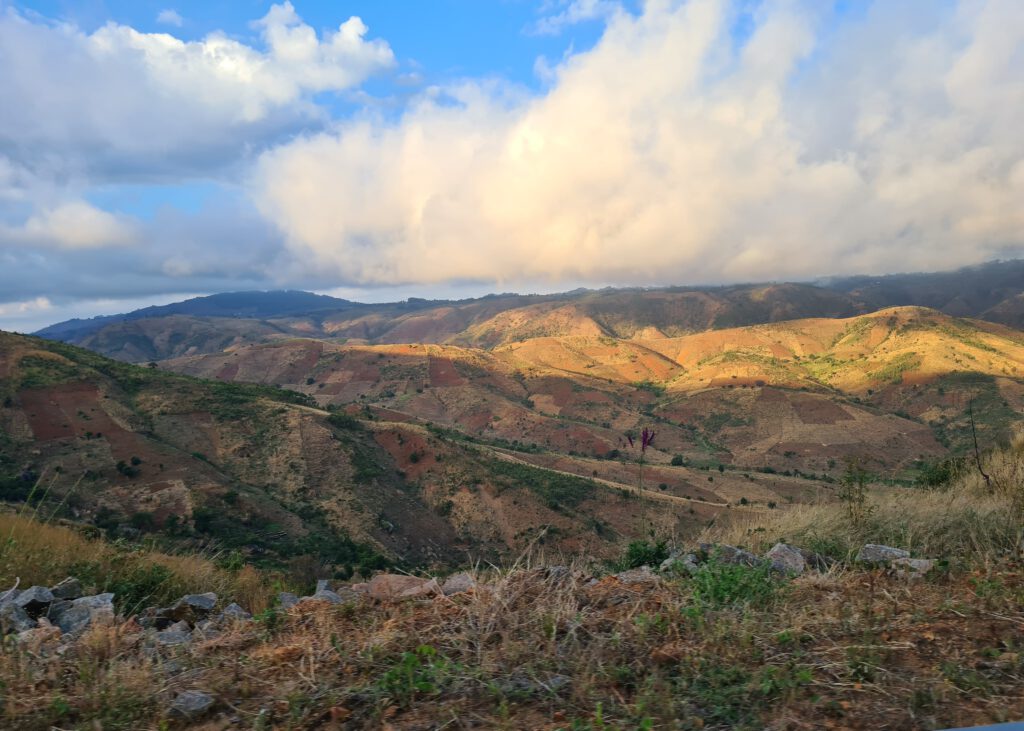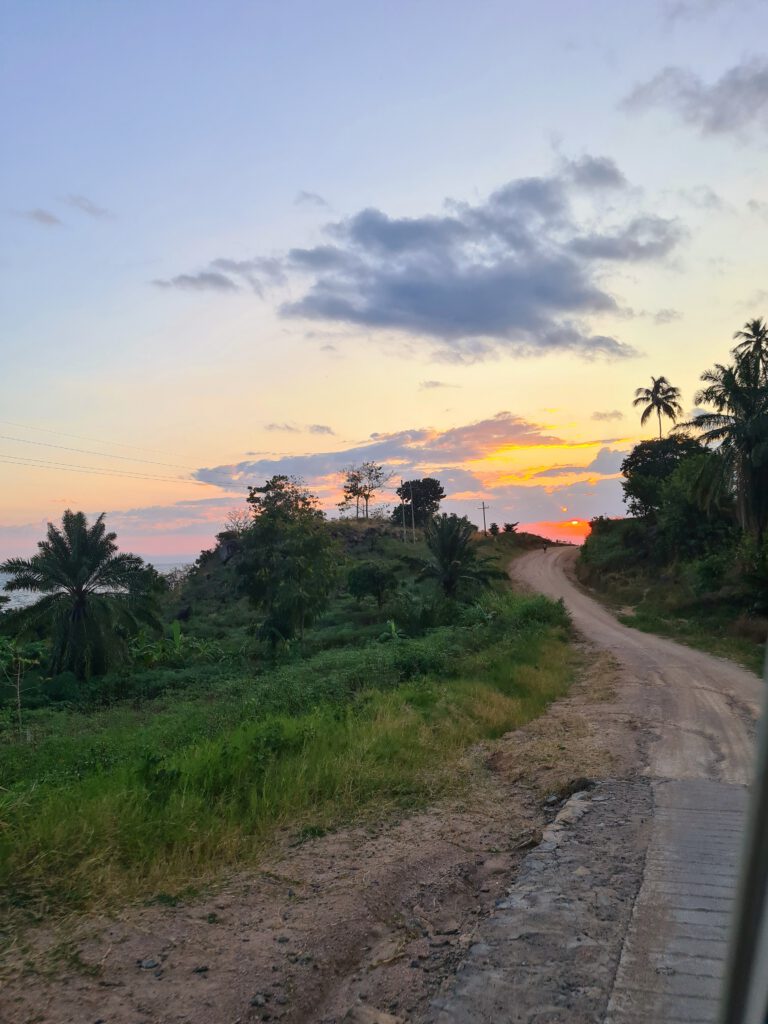From Ilembula to Songea
Our journey to Liuli continued as we prepared to travel from Ilembula to Songea. Although the hospital's physiotherapist had reserved seats for us on the 08:30 bus in advance, several buses from the Super Feo Express travel company passed us by first—they were too full. We had to call the hospital again to secure another reservation and were finally able to board a bus at 11:40. Due to the lack of available seats, I ended up sitting on a seat mat in the entrance area, hoping the bus wouldn’t have to brake hard. After about 40 minutes, the bus made its first stop, and I managed to grab a vacant seat. For the next four hours, we travelled through untouched, mountainous landscapes, only occasionally interrupted by small villages with corrugated iron-roofed houses. The cell phone network here is very limited. Since hardly anyone on the bus seemed to speak English, we were confused about which bus stop to get off at on our way to Songea. Eventually, we got off randomly at the second stop and found ourselves on a dusty street lined with stores and, most notably, numerous motorcycles. The owners immediately wanted to load us up with our luggage and transport us. We insisted on being taken in a bajaji (tuk-tuk), and one was promptly brought for us.
We stayed in Songea for three nights, booking into a hotel that the hospital secretary from Liuli had described to us as nice and cheap . Cheap It was indeed cheap—15,000 shillings per night (approximately €5.50)—but unfortunately, there was no running water in the bathroom, and the toilet was traditional Tanzanian style, meaning we had to make do with a hole in the floor connected to a sewage pipe. However, we were immediately provided with a large green bucket of warm water, which, judging by the smell, had just been heated over a fire, and a small bucket for rinsing, showering, and washing our hands. Given the fist-sized holes in the mosquito net (at least there was one), we were grateful for our malaria prophylaxis.
Songea
Wir treffen uns mit Dr. Ndimbo zum chai ya asubuhi We met Dr. Ndimbo for chai ya asubuhi at our new regular restaurant, where we now have all our meals. He greeted us warmly with a hug, and we got to know each other a little. Dr. Ndimbo hails from Liuli and not only began his medical career there but also practiced as a general doctor at St. Anne's Hospital for many years. He knows a great deal about Liuli, the origins and development of the hospital, and is happy to share his experiences with us. We asked one question after another to gain a better understanding. “How have tropical diseases evolved in the region?” we inquired. The doctor informed us that they now very rarely encounter cholera, dengue fever, leprosy, onchocerciasis, or schistosomiasis. Classic childhood diseases, including measles, tetanus, diphtheria, and many other vaccine-preventable illnesses, are also seldom seen here, as newborns are vaccinated promptly after birth. I also learned that the population receives a single dose of anti-parasite medication every year. In contrast, malaria remains the most common reason for treatment at St. Anne's Hospital, but I’ll share more about that when we arrive in Liuli.
After breakfast, Dr. Ndimbo took us on a tour of the Songea Regional Referral HospitalI was truly impressed by the hospital's resources. They have an excellent laboratory capable of conducting even specialized hormone tests, a recently purchased computed tomography (CT) scanner, and a dental practice equipped with a dental X-ray machine. It's evident that the government is heavily investing in this state-run facility, and I felt delighted for the residents of Songea. In contrast, we can only dream of such facilities at the Anglican church hospital in Liuli, where we don’t even have a stable power supply and the roofs are leaking. I thought to myself that medical care is really very unevenly distributed.
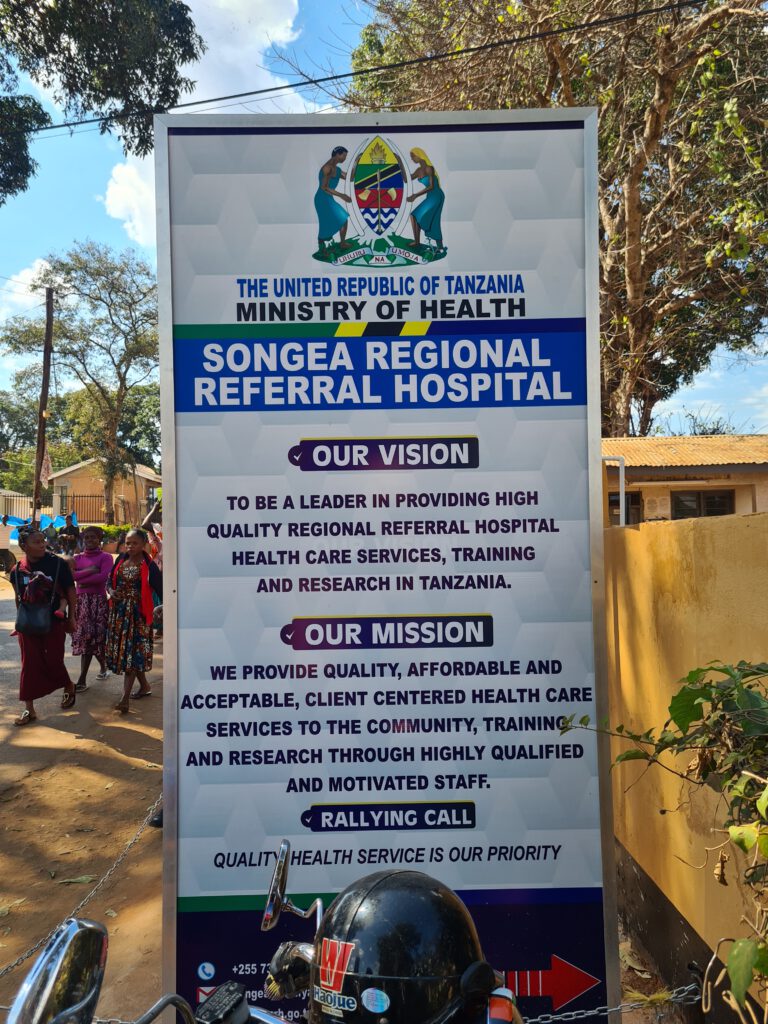
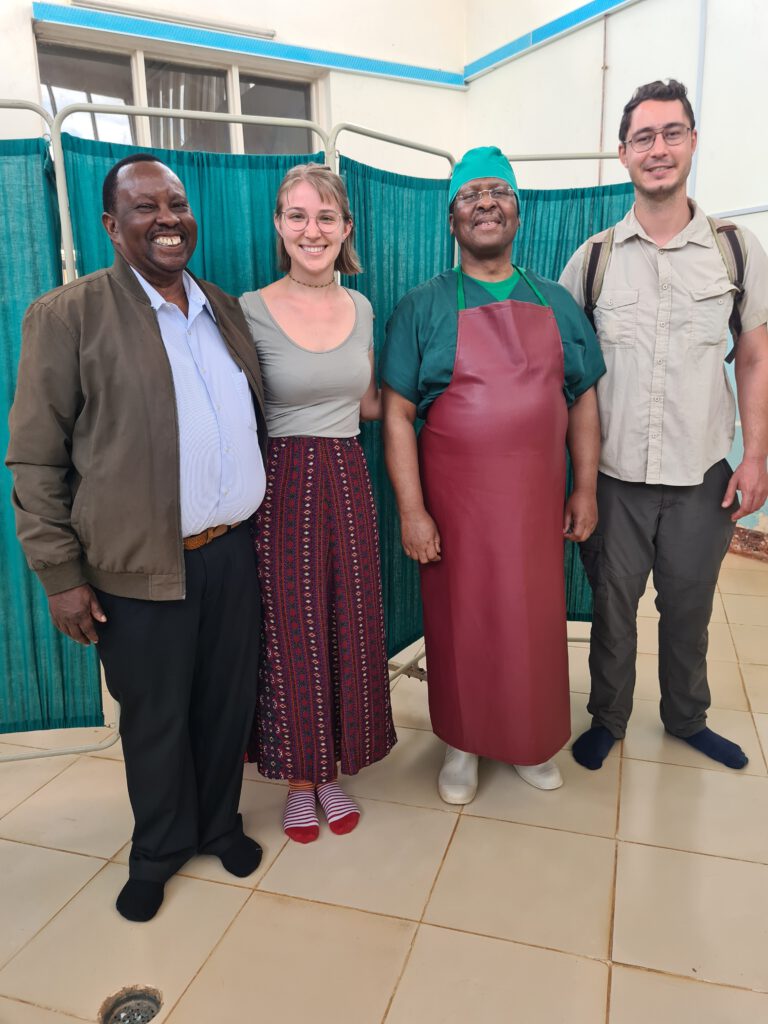
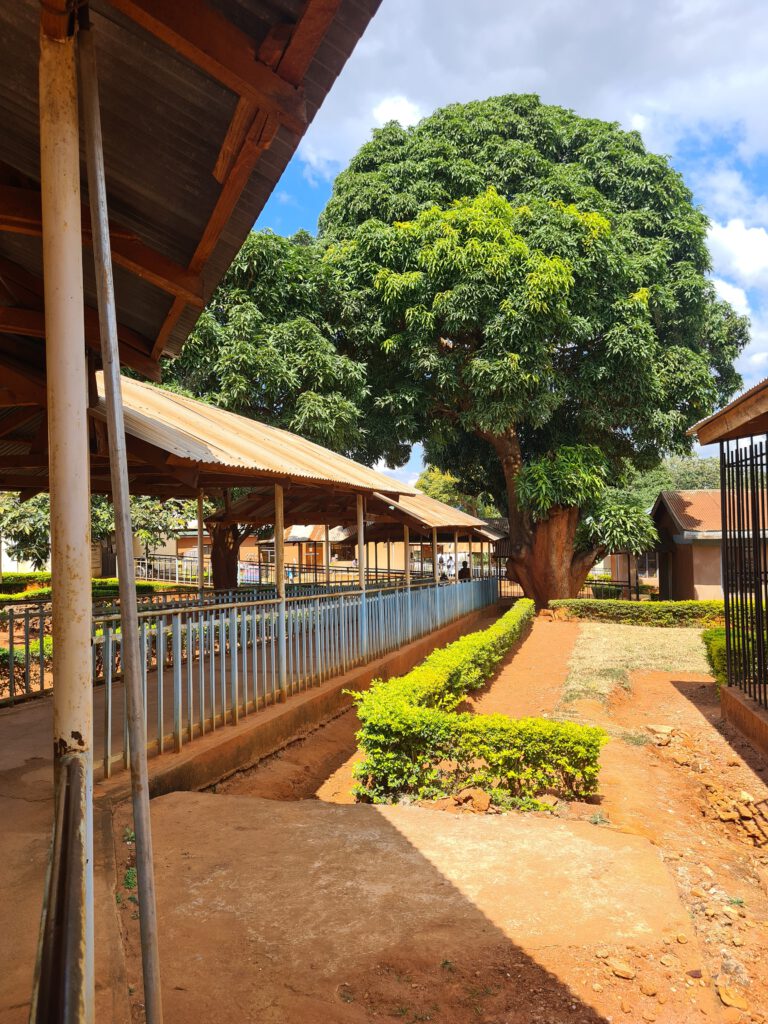
After shaking many hands and asking countless questions, Dr. Ndimbo showed us his workplace—the School of clinical officers, a professional group that falls somewhere between nursing and medical staff. There, we spoke with Dr. Ndimbo and the deputy principal about one of Liuli's biggest challenges: the lack of staff. The village is so remote that most doctors do not stay longer than two years. Moreover, the two doctors currently working are not employed by the government, which means the hospital has to cover their salaries—a difficult task, as we know. Although Liuli is remote, it has direct beach access to the beautiful Lake Nyasa, we were told, but Dr. Ndimbo and the principal only smiled slightly. They also discussed the high unemployment rate among doctors in Tanzania. We couldn't understand why unemployed doctors wouldn't want to work in Liuli for slightly less money instead of not practicing medicine at all. They couldn’t or didn’t really want to explain this to us but talked about financial incentivesincentives to lure doctors from Songea to Liuli for a few days or weeks. We let this information sink in and focused more on the School of clinical officersThe training lasts three years and, similar to Germany, includes both theoretical and practical units. The students receive a relatively comprehensive overview of many different medical specialties, it seems. It just doesn't delve into as much detail as in medical school, we were told. The biggest challenge at the school right now is the lack of computers, which are urgently needed for teaching. Dr. Ndimbo and the principal therefore asked us to use our contacts in Germany to find donors for two laptops. We ended up meeting the graduating class, who have to sit their exams in a few weeks. We received a very warm and enthusiastic welcome and were asked to take a group photo, a request we were happy to comply with.

We also used our stopover in Songea to meet Dr. Hinju for dinner at our local restaurant. He is an ophthalmologist and also feels very connected to Liuli. We actually wanted to invite him to visit St. Anne's Hospital regularly and treat patients, as there are no eye specialists in the Liuli area. But Dr. Hinju told us that such a visit was already being planned, and we were very happy about this news. Eye diseases are very common in and around Liuli. Many people suffer from impaired vision, but there is usually no access to visual aids. Dr. Hinju and his team are therefore a great asset to St. Anne's Hospital.

On our last day in Songea, we met Mr. Gift, the hospital secretary, who ran some errands with us in Songea. We bought a few items of equipment for the Doctors House, where we will be living for the next two months. We then went to a pharmacy together to place a bulk order for medicines and hospital supplies. Tim found out exactly which medicines are sold in the pharmacy, and we also bought some preparations that were not on Mr. Gift's list, such as intravenous oxytocin to treat heavy bleeding after a birth. When we checked the order at the end, some items were missing and still had to be provided by the pharmacy staff. However, there were also items that we didn’t pay for at all or at least not in the quantity we paid for, so it all balanced out quite well. In the end, we spent Tanzanian shillings in the millions. We loaded up the jeep that Mr. Gift had brought to Songea, and our luggage had to be strapped to the roof to make room for the medication and for us in the back. We ran errands in Songea, as there is no large pharmacy in Liuli, only the tiny Duka La Dawa (medicine store), which is more like a mini drugstore. There are also no ATMs in Liuli, so we stock up at the machines until we reach our daily limit.
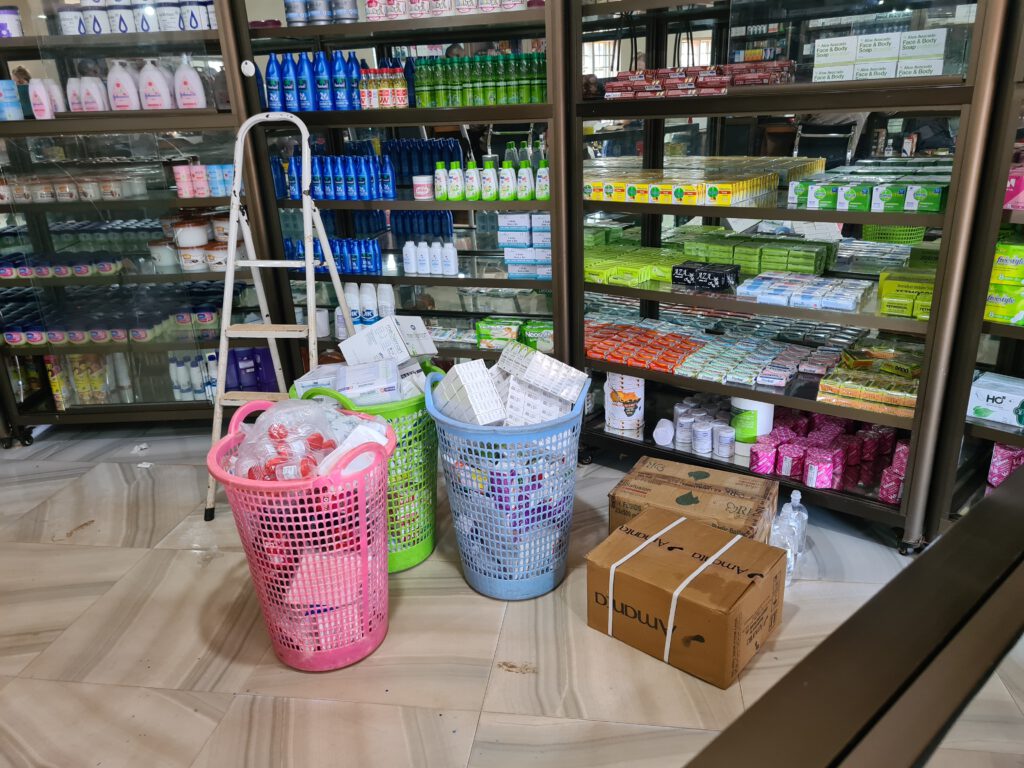

After the shopping trip, we drove to the Anglican diocese to meet the Bishop of Ruvuma in person. As it turned out, the bishop is an incredibly friendly, polite, and thoughtful man. He profusely thanked Friends of St. Anne's for all their support over the years. He also acknowledged that Tim is an exceptional, highly motivated, and committed first board member of the association, and I have to agree with the Bishop. We arranged to meet him again in September to discuss new projects at the hospital.
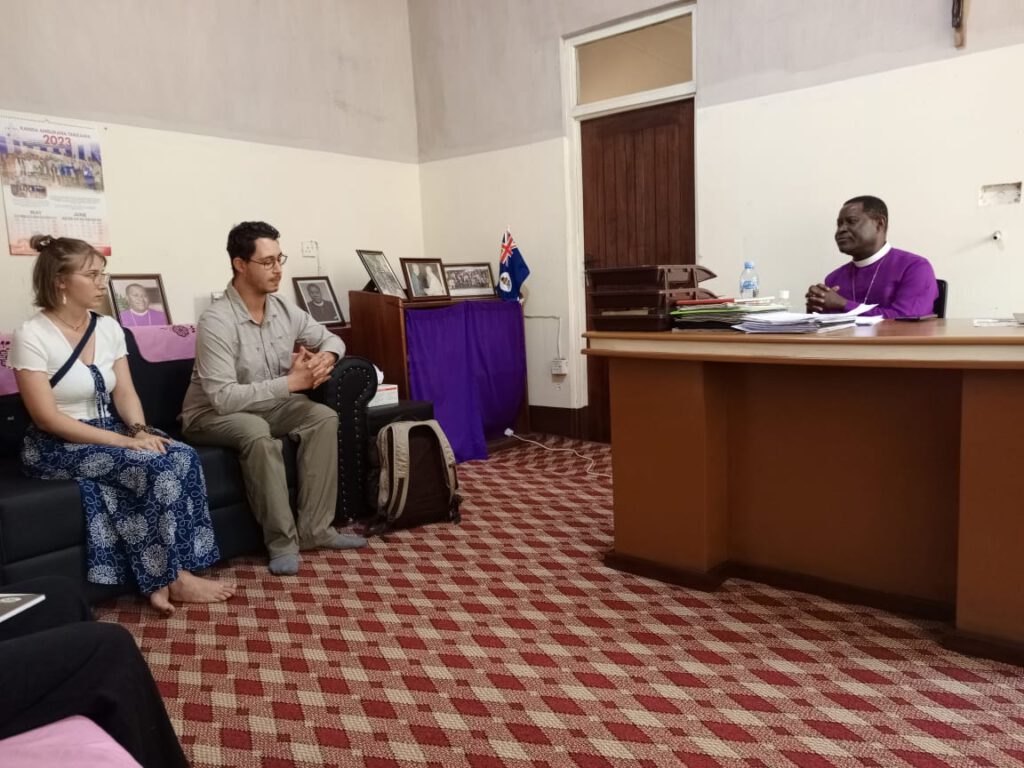
In the afternoon, we got into the packed jeep and headed south. We finally had our final destination, Liuli, in sight. Soon after Songea, the surroundings became more mountainous and the road more winding, but also less busy. We climbed higher and higher under a sun that was already in the west, and I realized that the area is truly beautiful. For the first time since my arrival in Tanzania, I felt that nature still rules over people here, not the other way around. Only now did I realize that some things about the cities really bothered me, namely the garbage, the crowded streets, and the constant alertness needed to avoid being hit by a passing motorcycle or car. We passed small, sleepy villages, with farmland stretching across the hilly landscape in between. The setting sun cast a beautiful light on the hillsides, which glowed in shades of brown, red, yellow, and green. After Mbamba Bay, the asphalt road turned into a dusty dirt track. This didn’t seem to bother the driver, as he continued at the same speed. I was told that it was only a few kilometers to Liuli. The sun was just setting over Lake Nyasa, and I was really looking forward to seeing so many beautiful sunsets over the next two months. Shortly before we arrived, I experienced a brief Bali vibe, even though I’ve never been to Bali before, as rice fields stretched as far as the eye could see to the right and left of the road. We finally arrived in Liuli. The sun had already set completely. We were already expected at the Doctors House and were helped to unload our luggage and medicine boxes. There were still two medical students from Vienna at the Doctors House, with whom we chatted a little and had a delicious Tanzanian dinner before falling tired into
